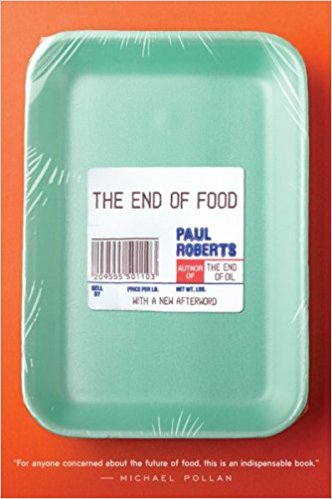The End of Food Summary

4 min read ⌚
 The Coming Crisis in the World Food Industry
The Coming Crisis in the World Food Industry
During their evolution, humankind has habituated to meat-based diet as a primary energy source. They have managed to grow corn, wheat, and rice.
Who Should Read “The End of Food”? And Why?
Customers get their food from advanced distribution infrastructure. Cheap food is just a fantasy, considering the fact that the process includes many food production costs. The writer inspects what would happen if a shortage of fuel, water, or both happens.
Furthermore, he clarifies why financial, political and social issues bury the food system. All things considered, we recommend this book to all the readers that are interested in comprehending the problems associated with feeding the population on Earth.
About Paul Roberts
 Paul Roberts is an American writer and journalist. He has authored two nonfiction books so far, The End of Oil (2004) and The End of Food (2008). He has published his works in the Los Angeles Times, Washington Post, and National Geographic.
Paul Roberts is an American writer and journalist. He has authored two nonfiction books so far, The End of Oil (2004) and The End of Food (2008). He has published his works in the Los Angeles Times, Washington Post, and National Geographic.
He has also been a regular contributor to Harper’s Magazine. The topics he writes about are mostly connected to the economics, nature and technology, and how they all relate to each other.
“The End of Food Summary”
Societies that succeeded to generate excessive goods formed the first cities and villages.
Or, in other words, first civilizations were built around food economies. Theorists argued that since population grows geometrically, and good production linearly, demand would soon surpass supply.
However, as time passed, and new technologies emerged, people were able to produce and distribute food in a more efficient manner. Countries even became superabundant, especially after discovering the fertilizer.
Scientists tried to make crops more uniform, and therefore simpler for mechanical harvests. They applied the same logic to keeping animals and decided to add supplements to their food to make them meatier and more suitable for mass production.
But this way of growing crops and animals soon resulted in creating huge surpluses that drove the prices down.
Overproduction is not that positive. First, excess food gets thrown away and wasted. Next, prices drop since the supply is higher than the demand. Higher crop production rates are linked to using more fertilizer, pesticides and more chemicals which pollute the soil.
These events have created two types of nations. On the one hand – nations which can import what they need, and on the other – developing countries that depend on import and can barely feed their people.
By supporting the lowering of world trade barriers, food companies have helped the food business to go global. Big companies get the dominant role in the world’s food supply.
To boost their profits, they create brands and add value to their offerings. The negative side is that supermarkets may squeeze and expel manufacturers from the market since consumers look for goods that are cheap, safe and uniform.
The basis of the world food economy is the notion that countries can prosper if they sell crops they are best at growing and import everything else. However, this theory is flawed for a simple reason – it is based on developed farming districts globally.
Many farmers in economically struggling countries cannot afford to buy food, and they would have to – if they don’t grow it.
In the long run, one thing is clear: to be able to meet the global food requirements; people will have to eat less meat. The system and its current way of functioning are not sustainable. The increased use of fertilizers and pesticides degrade the environment.
Indeed, it is true that industrial farming is more affordable and offers lower prices, but the environmental costs are innumerable. The environmental damage will not only threaten future crop outputs but will also cost the nations billions.
Key Lessons from “The End of Food”
1. Unintended hazards and costs
2. The gene pool
3. Going organic
Unintended hazards and costs
Food poisoning and the bacteria that is causing it has always been around. However, the factory based global food economy can spread untraceable food illnesses worldwide. Salmonella in the present is affecting more than a million people a year.
This is due to the fact that the industry is treating livestock with antibiotics for years.
Bacteria are becoming resilient, and food safety cannot be 100% ensured anymore. The same thing is happening to Escherichia coli too.
The bacteria have grown resistant because the world is feeding cattle with corn-based meals. Some of these diseases spread through the water system or even on the wind.
The Gene Pool
Science increasingly makes efforts to try to manipulate genetic data at a fundamental level. Scientists are already able to transfer genes from one kind of product to another. All this is done in an attempt to reinforce specific good traits and wanted characteristics.
Nevertheless, genes are unpredictable, especially from the second generation – on. In reality, no matter how much scientists try, altered crops cannot resolve all food-related problems.
Going organic
Organic farming is a different possibility compared to the status quo, which is industrial farming. Supporters of organic farming are rejecting and condemning factory farming.
However, most people would not give up meat or pay more for locally and organically grown foods. Although natural food and its purchase are reasonable and beneficial in many ways, It is not always people’s first choice.
The truth is that real and lasting change comes slowly, only through educating the consumers and changing their current lifestyles.
Like this summary? We’d Like to invite you to download our free 12 min app, for more amazing summaries and audiobooks.
“The End of Food” Quotes
Transportation is...problematic. In many developing countries...rail lines are limited or nonexistent and roads are in appalling shape. Share on X China used the promise of its massive markets to persuade U.S. officials to override safety concerns about imported food. Share on X Much of that price drop has come from Wal-Mart’s success at cutting labor costs, which...has driven down average U.S. wages by 2.2%. Share on X Demand for grape flavor by makers of sodas, gum, candy and other foods now exceeds the quantity of grape flavor produced naturally – that is, in actual grapes – by...ten to one. Share on X In 1900, the average American family spent half its household income on food. Share on XOur Critical Review
According to the research on the worldwide food delivery system conducted by Paul Roberts, food production costs have increased, just like other costs of other contemporary products.
This comprehensive analysis truly provides valuable insights for various personalities, who want to expand their knowledge on the food-supply issue.








